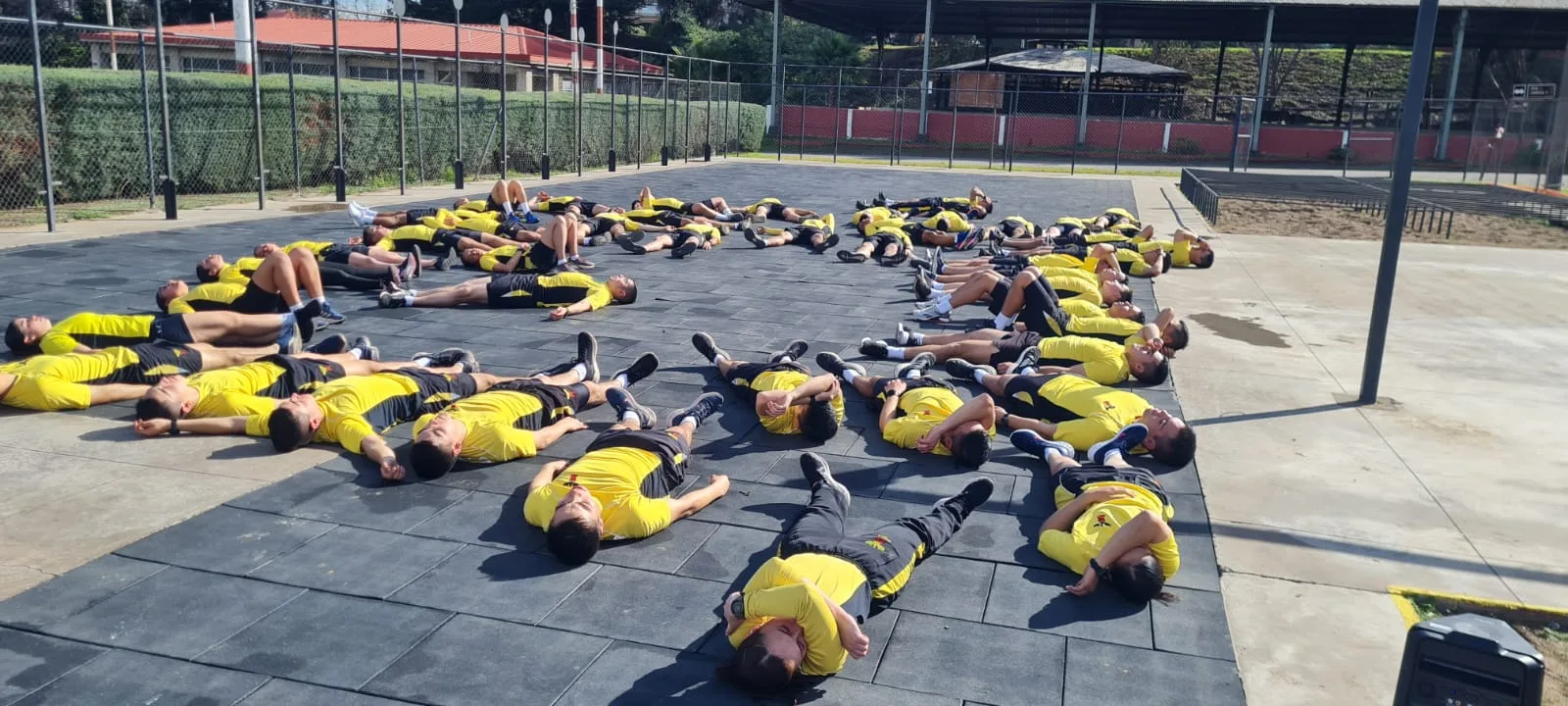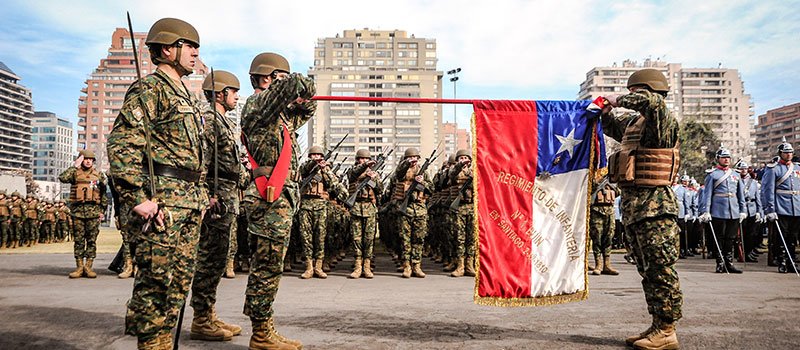Training while keeping truly fit for duty
There are different training-forms for physical exercise. Nowadays High Intensity Interval Training (HIIT) and Crossfit style sessions get a lot of attention. Most people think they have only trained well once they have to recover in a pool of sweat afterwards. These types of exercise are actually quite counter-productive for first responders (on call) or military members who are supposed to go into the field the next day. Of course you can push yourself through some sore muscles. But do you still have the same endurance and/or speed after such sessions? Especially when it truly counts. Probably not.
Kettlebell Training
Kettlebell training is one of the specific types of training that has a wide variety of transfer. That means that performance in several areas will improve when you start training with kettlebells (when done correctly). And when you train at moderate intensity (nearly) every day, you will make sure you are ready for whatever life (or your job) throws at you.
As a certified Kettlebell Instructor with StrongFirst, I will refer to two books written by StrongFirst founder and chairman Pavel Tsatsouline. He introduced the Russian kettlebell to the West in 1998 and started the kettlebell revolution.
A former Soviet Special Forces physical training instructor, he became a Subject Matter Expert to the elite of US military and law enforcement, including the Marine Corps, the Secret Service, and the Navy SEALs. Special operations units in two countries, closely allied with the US, have implemented his training system. Pavel founded StrongFirst, the “school of strength”, to bring “low tech/high concept” methods of achieving high performance and resilience to men and women from all walks of life, not just elite warriors and athletes.
The Quick and the Dead
“The Quick and the Dead” is the title of the latest book of Pavel and it is focussed on a minimalistic training method that will take 12 – 30 minutes per session, 2 – 3 sessions per week and is supposed to maximize your performance at the lowest biological cost. It is possible to add other training elements, but only after these specific sessions.
Basis for the Quick and the Dead (Q&D) sessions are power push-ups and kettlebell swings. The program focuses on maximizing power production and brief bouts of 5 or 10 reps and sufficient rest for a set time. The rest is nonetheless not enough to fully recover. The volume for a training day will be varying between 40 and 100 reps and requires between 12 and 30 minutes (with 20 reps in 6 minutes per series).
Benefits of this type of program are numerous and vary from hypertrophy (building muscle mass) to aerobic power. It even will have benefits for keeping your skills while aging. All those benefits, without the build-up of lactic acid in your muscles (which will reduce your speed and strength and therefor power).
The program includes a test at the beginning of the program and after that every 6 weeks. There are people reporting improvements in forms of exercise that they not even have been training in those periods. The biggest benefit is that the program is designed to minimize deconditioning during layoffs. These benefits are more prominent when the program has been followed for a longer period. This program is meant to be practiced for months and years, not weeks. It goes too far for this article to fully explain the background of this design and benefit.
I will not describe the whole program and the specifics about testing here. For that you should either buy the book or look for a StrongFirst certified coach. This way you will get the most benefits from the program and you do not risk injuries because a lack of technique. The book “The Quick and the Dead” is available as Kindle or paperback version on Amazon.
It is not a regimen for persons who just start with kettlebell training. The program is for advanced athletes, who are proficient in solid kettlebell swings, and can produce sufficient body tension during the exercises. There is also a program for athletes who are not at this level yet.
Simple & Sinister
In case you are not that proficient with kettlebell swings yet, I can highly recommend you getting the book and follow the training program from “Kettlebell Simple & Sinister”. The main components of this program are Kettlebell Swings and Turkish Get-ups. So, once again a minimalistic training program for which all you need is: a kettlebell and some space to train.
For this program there is also a focus to go for quality of the movements. The rest periods are very simple: you are ready for the next set when you can talk again. Your strength and endurance will increase slowly but steadily over time and the rest periods will shorten.
For this program I also would like to refer you to the book to read about the background, or even better: look for a StrongFirst Certified coach who can make sure your technique is correct. There is a big difference between ‘swinging a kettlebell’ and ‘performing a kettlebell swing’. The first will put you at risk of all kinds of injuries, while the latter will give you all the benefits.
“Simple & Sinister” is also available as Kindle or paperback version on Amazon.
Conclusion
In order to be truly fit for duty there are training forms for which you only need a kettlebell and a limited amount of time per training session. These sessions also are meant to make sure your body is ready for what life (or the job) throws at you. While the occasional HIIT and/or Crossfit session are good moments to test your body, doing them too frequently will wear you out because of the long(er) recovery period you need. The training forms from Q&D and S&S can even be done while on deployments or while being on call.
¿Entrenado para el cumplimiento del deber?
TRADUCCIÓN:
Entrenar mientras te mantienes verdaderamente en forma para el cumplimiento del deber
Existen diferentes formas de entrenamiento para mantener el estado físico. Actualmente el entrenamiento de intervalos de alta intensidad (HIIT) y las sesiones de estilo crossfit son las más populares. En este sentido, muchas personas creen haber entrenado bien solamente si después tienen que recuperarse en un charco de sudor. En realidad, estos tipos de ejercicios son bastante contraproducentes para socorristas (de servicio) o militares que deban ir a terreno al día siguiente. Sin duda, puedes sobreponerte a algunos músculos adoloridos, pero ¿todavía tienes la misma resistencia y/o velocidad después de tales sesiones, especialmente para cuando sea realmente necesario?, probablemente no.
Entrenamiento con pesas rusas (Kettlebell)
El entrenamiento con pesas rusas es uno de los tipos de entrenamiento específicos que tiene una amplia gama de transferencia. Eso significa que el rendimiento mejorará en varias áreas cuando comiences a entrenar con pesas rusas (si lo haces correctamente), y cuando entrenes a una intensidad moderada (casi) todos los días, te asegurarás de estar listo para lo que sea que te depare la vida (o tu trabajo).
Como instructor certificado de Kettlebells con StrongFirst, me referiré a dos libros escritos por el fundador y presidente de StrongFirst, Pavel Tsatsouline, quien introdujo la pesa rusa en Occidente en 1998 y comenzó la revolución de las pesas rusas.
Ex instructor de entrenamiento físico de las fuerzas especiales soviéticas, se convirtió en un experto en la materia para la élite de las fuerzas armadas y policiales estadounidenses, incluidos el Cuerpo de Marines, el Servicio Secreto y los SEAL de la Marina. Unidades de operaciones especiales en dos países, estrechamente aliadas con los Estados Unidos, han implementado su sistema de entrenamiento. Pavel fundó StrongFirst, la “escuela de la fuerza”, para ofrecer métodos de “baja tecnología / alto concepto” para lograr un alto rendimiento y resistencia para hombres y mujeres de todos los ámbitos de la vida, no solo guerreros de élite y atletas.
Los rápidos y los muertos.
“The Quick and the Dead” es el título del último libro de Pavel y se enfoca en un método de entrenamiento minimalista que toma de 12 a 30 minutos por sesión, de 2 a 3 sesiones por semana y se supone que maximiza tu rendimiento con el menor costo biológico. Es posible agregar otros elementos de entrenamiento, pero solo después de estas sesiones específicas. La base para las sesiones Quick and the Dead (Q&D) son flexiones de fuerza y péndulos con pesas rusas. El programa se enfoca en maximizar la producción de energía y breves series de 5 a 10 repeticiones y descanso suficiente durante un tiempo establecido; Sin embargo, el descanso no es suficiente para recuperarse por completo. El volumen para un día de entrenamiento variará entre 40 y 100 repeticiones y requiere entre 12 y 30 minutos (con 20 repeticiones en 6 minutos por serie).
Los beneficios de este tipo de programa son numerosos y varían desde la hipertrofia (aumento de la masa muscular) hasta la potencia aeróbica, incluso tendrá beneficios para mantener tus habilidades mientras envejeces. Todos esos beneficios, sin la acumulación de ácido láctico en tus músculos (lo que reduciría tu velocidad y fuerza y, por lo tanto, tu poder).
El programa incluye una prueba al comienzo y después de eso una cada 6 semanas. Hay personas que informan mejoras en ejercicios que ni siquiera han estado entrenando en esos períodos. El mayor beneficio es que el programa está diseñado para minimizar el “desacondicionamiento” durante los periodos sin entrenar y estos beneficios son más notorios cuando el programa se ha seguido por un período más largo. Este programa está diseñado para ser practicado durante meses, no años ni semanas pero es demasiado extenso para explicar completamente los antecedentes de este diseño y sus beneficios en este artículo.
No describiré todo el programa y los detalles sobre las pruebas aquí, para eso debes comprar el libro o buscar un entrenador certificado por StrongFirst. De esta manera, obtendrás el mayor beneficio del programa y no corres el riesgo de sufrir lesiones por falta de técnica. El libro “The Quick and the Dead” está disponible en versión Kindle o de bolsillo en Amazon.
Este, no es un régimen para personas que recién comienzan con el entrenamiento con pesas rusas, el programa es para atletas avanzados que dominan los péndulos con dichas pesas y pueden producir suficiente tensión corporal durante los ejercicios. Sin embargo, también hay programas para atletas que aún no están en este nivel.
Simple y siniestro
En caso de que todavía no seas tan hábil con los péndulos de kettlebell, te recomiendo que obtengas el libro y sigas el programa de capacitación de “Kettlebell Simple & Sinister”. Los componentes principales de este programa son Kettlebell Swings y Turkish Get-ups. Entonces, una vez más encontraras un programa de entrenamiento minimalista donde todo lo que necesitas es una pesa rusa y algo de espacio para entrenar.
Este programa también tiene un enfoque en la calidad con que ejecutas los movimientos. Los períodos de descanso son muy simples: estás listo para la siguiente serie cuando puedas volver a hablar. Tu fuerza y resistencia aumentarán lenta pero constantemente con el tiempo y los períodos de descanso se acortarán.
Para este programa también considero recomendarte leer el libro sobre los antecedentes, o incluso mejor: busca un entrenador certificado por StrongFirst que pueda asegurarse de que tu técnica es la correcta. Hay una gran diferencia entre “balancear un kettlebell” y “realizar un péndulo de kettlebell”. El primero te pondrá en riesgo a todo tipo de lesiones, mientras que el segundo te brindará todos los beneficios. “Simple & Sinister” también está disponible como versión Kindle o de bolsillo en Amazon.
Conclusión
Para estar realmente en forma para el cumplimiento del deber, existen programas de entrenamiento para los que solo necesitas un kettlebell y una cantidad limitada de tiempo por sesión de entrenamiento. Estas sesiones también están destinadas a asegurar que tu cuerpo esté listo para lo que la vida (o el trabajo) te depare. Si bien las sesiones ocasionales de HIIT y/o crossfit son buenas ocasiones para evaluar tu cuerpo, hacerlo con demasiada frecuencia lo desgastará debido al largo período de recuperación que se necesita. Los programas de capacitación de Q&D y S&S incluso se pueden realizar cuando estés desplegado en operaciones o cuando estés de servicio o de guardia.






For those interested, Pavel Tsatsouline recently was with Joe Rogan and he discussed certain aspects from this article as well. https://www.youtube.com/watch?v=Rm0GNWSKzYs